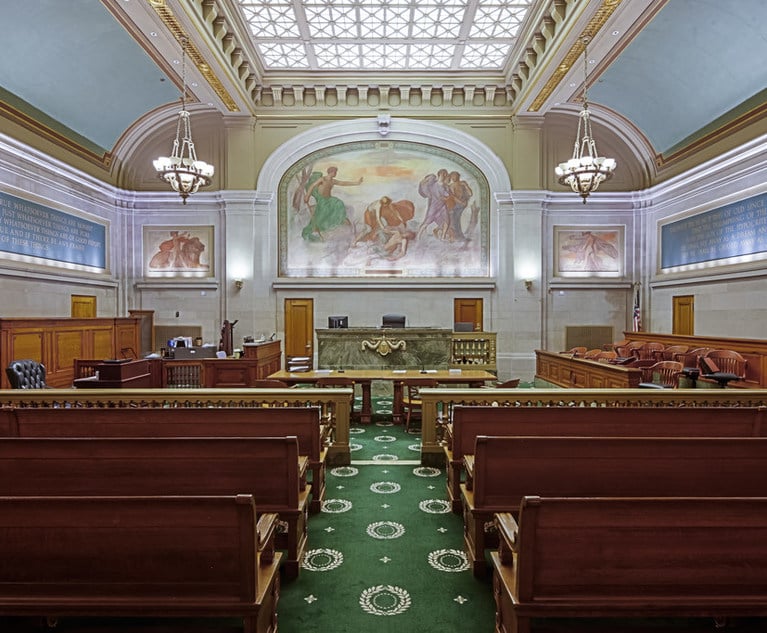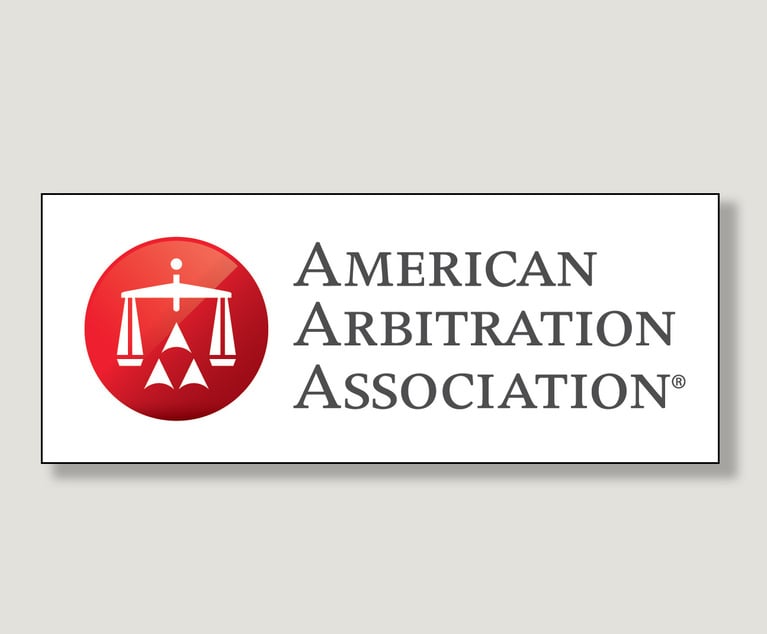Second Circuit Wrangles With Workplace Discrimination Question
The latest test of whether part of the Civil Rights Act can be read to bar workplace discrimination because of sexual orientation proved…
January 20, 2017 at 05:01 PM
5 minute read
The original version of this story was published on New York Law Journal
 Plaintiff Matthew Christiansen and attorney Susan Chana Lask
Plaintiff Matthew Christiansen and attorney Susan Chana Lask
The latest test of whether part of the Civil Rights Act can be read to bar workplace discrimination because of sexual orientation proved complicated Jan. 20 at the U.S. Court of Appeals for the Second Circuit.
A three-judge panel wrestled with the impact of a U.S. Equal Employment Opportunity Commission about-face on the issue, and the court's power to overturn its own precedent saying Title VII doesn't cover sexual orientation.
“It's not about sex per se—it doesn't matter who you slept with last night,” attorney Susan Chana Lask said for plaintiff Matthew Christiansen. “It's about skills.”
Christiansen, a creative director at DDB Worldwide Communications Group and an openly gay man, claimed supervisor Joe Cianciotto subjected him to ridicule and abuse by making extreme anti-gay comments, passed around a picture of Christiansen's face pasted over a woman in a bikini in the “gay sexual receiving position” and then posted it online, and drew offensive pictures of Christiansen on an office whiteboard. Included were comments about AIDS addressed to Christiansen, who is HIV-positive.
Last March, U.S. District Judge Katherine Polk Failla of the Southern District of New York, while decrying the treatment as “reprehensible,” dismissed the case, saying she was hamstrung by the circuit's decision in Simonton v. Runyon, 232 F3d 33 (2d Cir. 2000) which said Title VII's bar on discrimination “because of … sex” did not mean sexual orientation.
Jan. 20, Judges Robert Katzmann, Debra Ann Livingston and Eastern District Judge Margo Brodie had several questions on whether they could overrule Simonton or whether it would require an en banc sitting of the court to do so. Christiansen's case may come under Title VII's reach for discrimination based on sexual stereotyping, they noted, but the circuit in Simonton said clearly that a plaintiff may not use “a gender stereotyping claim to bootstrap protection for sexual orientation into Title VII.”
Lask argued the times have changed and cited the successful fights at the Supreme Court to ban prohibitions on gay sex and recognize same-sex marriage—and she urged the circuit to adopt a broader definition of “sex” in the law.
The EEOC changed positions in 2015 to state the statute logically covers sexual orientation, and the agency has succeeded in persuading some district courts that is the case.
Significantly, the lone appellate court to address the issue is the Seventh Circuit, where a three-judge panel rejected sexual orientation in Hively v. Ivy Tech Community College, 830 F. 3d 698 (2016), only to have the full court vote in October to vacate the opinion and rehear the case en banc.
Katzmann asked Barbara Sloan of the EEOC Jan. 20 why the EEOC changed its position and why it should matter to the circuit.
“We recognize that the legal landscape has changed and the understanding of sex and sexual orientation has evolved over time,” said Sloan.
The Seventh Circuit and some districts, she said, have taken note that “it all boils down to the same thing—the employer takes sex into account when it discriminates based on sexual orientation.”
Jan. 20's appeal in Christiansen v. Omnicom Group, 16-748, drew several amici, including 128 members of Congress, who in a brief by Peter Barbur of Cravath, Swaine & Moore, said, “Simonton must be overturned because it relied on incorrect interpretations of congressional actions and outdated law to justify an incoherent interpretation of 'sex' under Title VII.”
Howard Rubin of Davis & Gilbert, for all defendants but Cianciotto, argued Christiansen's claims were not actionable and the statute of limitations had clearly expired. On the latter issue, unaddressed by Failla, Katzmann asked, “Why shouldn't it just go back to the district court?”
The circuit, Rubin answered, can decide it, but he would be “pretty comfortable” about prevailing on remand.
Rick Ostrove of Leeds Brown Law, arguing for Cianciotto, denied the depictions were offensive, and when Brodie disagreed, he insisted, “It's not an attack on sexual orientation merely because it's childish and shouldn't be in the workplace.”
Katzmann quoted the late Justice Antonin Scalia as saying statutory prohibitions often “go beyond the principle evil to encompass reasonably comparable evils.”
“Isn't this a comparable evil?” he asked.
“Quite frankly, I don't think this is the case for it,” Ostrove answered, and, when pressed by the court again, said, “I think that it's an evil and I think it shouldn't exist,” but it was up to Congress to make that call.
Livingston later asked Lask if she was arguing the EEOC shift in position “would give us the authority to reverse Simonton?”
Initially, Lask said yes, but then relied on the changes in the legal landscape on sexual identity, highlighted by the Seventh Circuit's reconsideration in Hively.
Copyright New York Law Journal. All rights reserved. This material may not be published, broadcast, rewritten, or redistributed.
NOT FOR REPRINT
© 2025 ALM Global, LLC, All Rights Reserved. Request academic re-use from www.copyright.com. All other uses, submit a request to [email protected]. For more information visit Asset & Logo Licensing.
You Might Like
View All

Sanctioned Penn Law Professor Amy Wax Sues University, Alleging Discrimination
5 minute read
Arbitrators Under Fire for Allegedly Forcing Workers to 'Stay or Pay' Employers
5 minute read
COVID-19 Vaccine Suit Against United Airlines Hangs on Right-to-Sue Letter Date
3 minute readTrending Stories
- 1'A Death Sentence for TikTok'?: Litigators and Experts Weigh Impact of Potential Ban on Creators and Data Privacy
- 2Bribery Case Against Former Lt. Gov. Brian Benjamin Is Dropped
- 3‘Extremely Disturbing’: AI Firms Face Class Action by ‘Taskers’ Exposed to Traumatic Content
- 4State Appeals Court Revives BraunHagey Lawsuit Alleging $4.2M Unlawful Wire to China
- 5Invoking Trump, AG Bonta Reminds Lawyers of Duties to Noncitizens in Plea Dealing
Who Got The Work
J. Brugh Lower of Gibbons has entered an appearance for industrial equipment supplier Devco Corporation in a pending trademark infringement lawsuit. The suit, accusing the defendant of selling knock-off Graco products, was filed Dec. 18 in New Jersey District Court by Rivkin Radler on behalf of Graco Inc. and Graco Minnesota. The case, assigned to U.S. District Judge Zahid N. Quraishi, is 3:24-cv-11294, Graco Inc. et al v. Devco Corporation.
Who Got The Work
Rebecca Maller-Stein and Kent A. Yalowitz of Arnold & Porter Kaye Scholer have entered their appearances for Hanaco Venture Capital and its executives, Lior Prosor and David Frankel, in a pending securities lawsuit. The action, filed on Dec. 24 in New York Southern District Court by Zell, Aron & Co. on behalf of Goldeneye Advisors, accuses the defendants of negligently and fraudulently managing the plaintiff's $1 million investment. The case, assigned to U.S. District Judge Vernon S. Broderick, is 1:24-cv-09918, Goldeneye Advisors, LLC v. Hanaco Venture Capital, Ltd. et al.
Who Got The Work
Attorneys from A&O Shearman has stepped in as defense counsel for Toronto-Dominion Bank and other defendants in a pending securities class action. The suit, filed Dec. 11 in New York Southern District Court by Bleichmar Fonti & Auld, accuses the defendants of concealing the bank's 'pervasive' deficiencies in regards to its compliance with the Bank Secrecy Act and the quality of its anti-money laundering controls. The case, assigned to U.S. District Judge Arun Subramanian, is 1:24-cv-09445, Gonzalez v. The Toronto-Dominion Bank et al.
Who Got The Work
Crown Castle International, a Pennsylvania company providing shared communications infrastructure, has turned to Luke D. Wolf of Gordon Rees Scully Mansukhani to fend off a pending breach-of-contract lawsuit. The court action, filed Nov. 25 in Michigan Eastern District Court by Hooper Hathaway PC on behalf of The Town Residences LLC, accuses Crown Castle of failing to transfer approximately $30,000 in utility payments from T-Mobile in breach of a roof-top lease and assignment agreement. The case, assigned to U.S. District Judge Susan K. Declercq, is 2:24-cv-13131, The Town Residences LLC v. T-Mobile US, Inc. et al.
Who Got The Work
Wilfred P. Coronato and Daniel M. Schwartz of McCarter & English have stepped in as defense counsel to Electrolux Home Products Inc. in a pending product liability lawsuit. The court action, filed Nov. 26 in New York Eastern District Court by Poulos Lopiccolo PC and Nagel Rice LLP on behalf of David Stern, alleges that the defendant's refrigerators’ drawers and shelving repeatedly break and fall apart within months after purchase. The case, assigned to U.S. District Judge Joan M. Azrack, is 2:24-cv-08204, Stern v. Electrolux Home Products, Inc.
Featured Firms
Law Offices of Gary Martin Hays & Associates, P.C.
(470) 294-1674
Law Offices of Mark E. Salomone
(857) 444-6468
Smith & Hassler
(713) 739-1250








